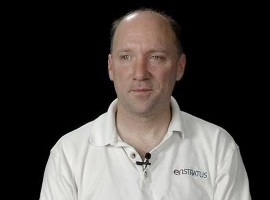InfoQ Homepage Architecture Content on InfoQ
-
Ward Cunningham on the Appeal of OOP and Dynamic Languages, Federated Wiki
Ward Cunningham talks about the continuing appeal of OOP and dynamic languages, asynchronous programming, and much more. Also: Ward explains the ideas behind his latest project Federated Wiki.
-
Interview with Barbara Liskov
Barbara Liskov keynoted at QCon London 2013 on the power of abstraction. Afterwards, InfoQ caught up with up with her to ask her about language design, modularity and distributed computation.
-
Incorporating Software Architecture in to the Agile Process
Through teamwork, an agile team can ensure the quality of its project's architecture, code hygiene, and other non-functional requirements by explicitly creating tasks for those concepts in each sprint. Alexander von Zitzewitz explains the importance of this method of agile development and how the use static analysis of code bases can help the "hard sell" of intentional architecture to management.
-
Big Data's Role in Etsy's Product Development
Etsy's approach to big data has been to give the entire organization visibility to different sources of data generated by their product as well as access to the experts who know how to use it. Nell Thomas explains her role at Etsy and how Etsy's view of big data has shaped its product's evolution.
-
Lean UX Explained
Learning from past projects, Jeff Gothelf helped synthesize Lean UX into a growing practice within software firms of all sizes, where teams focus on project outcomes and not output. When teams of varying competencies are brought together from the beginning of a project and given ownership, they are able to take responsibility for delivering a great client experience.
-
Brian McCallion on Enterprise Considerations for Cloud, Hybrid Strategies, and Amazon RedShift
Enterprise cloud specialist Brian McCallion talks about what's really holding back enterprises from adopting the cloud, how they should address their legacy applications, ways to avoid introducing complexity in distributed environments, the value of Amazon Redshift, and how technologists should broaden their knowledge and avoid specialization.

-
Duncan Coutts on Parallelism and Concurrency with Haskell, Distributed Programming with Cloud Haskell
Duncan Coutts explains the nature of Concurrency and Parallelism in Haskell, its threading and STM implementation, Erlang OTP's influence on CloudHaskell for distributed programming, Monads, and more.

-
George Reese on Enterprise Cloud Strategy, Trends, and API Design
Cloud leader George Reese answers questions across a wide range of topics. He shares his thoughts on pitfalls of enterprise cloud strategies, overrated technologies, whether IaaS standards matter yet, the relevance of private clouds, and the need for common sense when designing a API.

-
Michael Nygard - Redefining CAP
In this InfoQ interview, Michael Nygard explores some of the available loopholes in the CAP theorem helping architects to engineer distributed systems that meet their needs. He also discusses new patterns he’s observed since his book, Realease IT and shares his thoughts on continuous delivery, DevOps and ALM.
-
Jeff Sussna on Continuous Delivery, Cloud Journey and AWS Momentum
IT thought leader Jeff Sussna answers a range of questions about operational efficiency and cloud trends. He discusses new thinking around production freezes and adopting continuous delivery. Sussna explains how companies should understand the entire lifecyle of a customer’s cloud experience. Finally, he shares insight into AWS and their leading position in the cloud.
-
Brandon Carlson on Measurement, Professionalism and Fearing Our Customers
Brandon Carlson discusses his Agile journey, measurement and some code metrics tools he is working on. He also shares his views on professionalism and the importance of not fearing your customers.
-
Emil Eifrem on NoSQL, Graph Databases, and Neo4j
Emil Eifrem looks back at the history of Neo4j, an open-source, NoSQL graph database supported by Neo Technology. He describes some real world applications of graphs, domain modelling with graphs, and compares the performance of graph and relational databases. He also examines how Neo4j differs from other NoSQL and graph databases in the market and describes various Neo4j licensing options.
